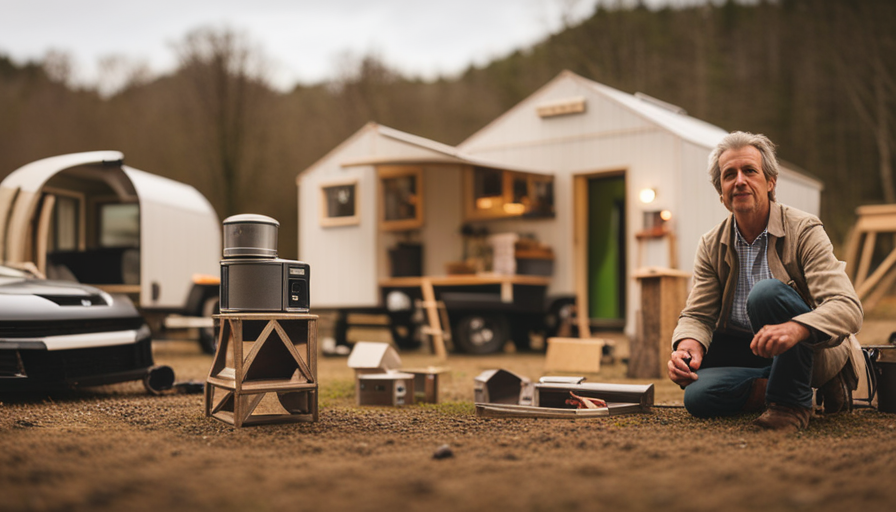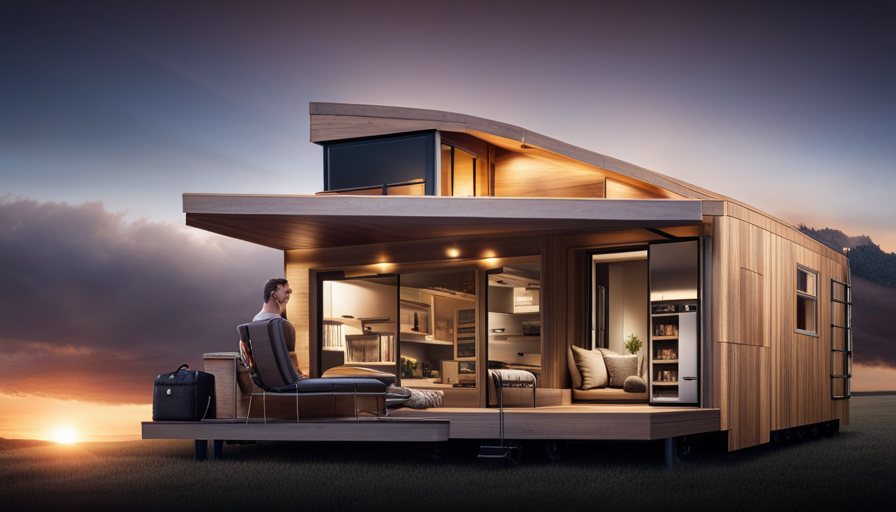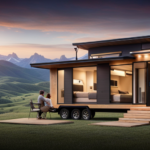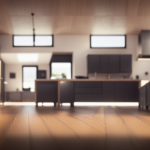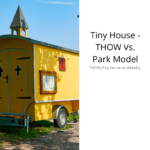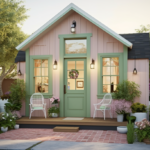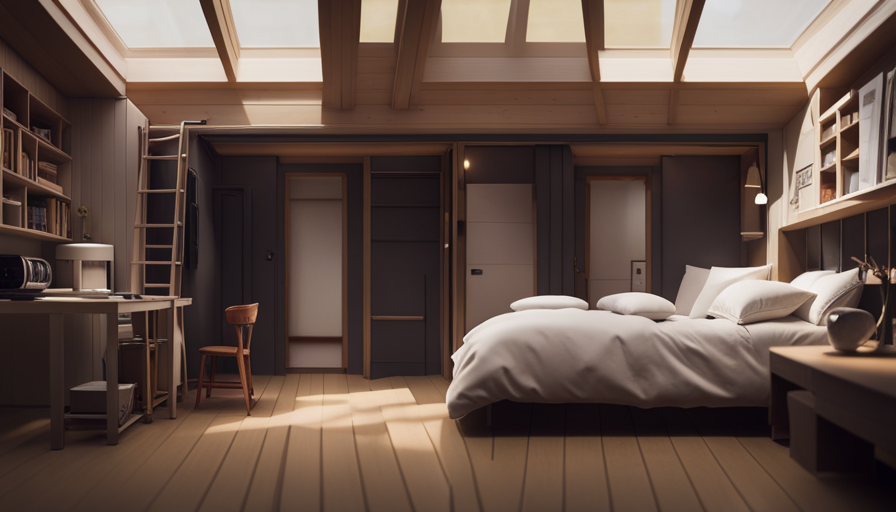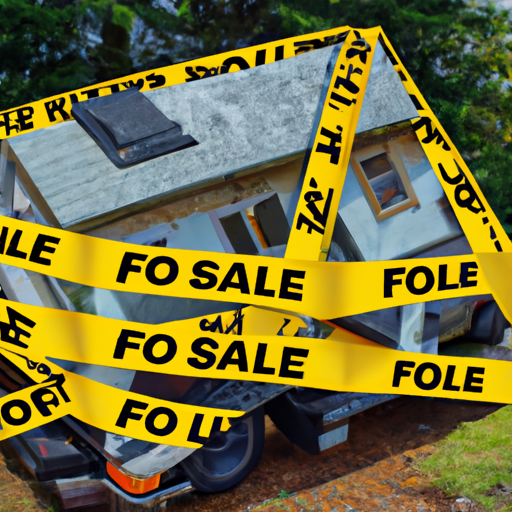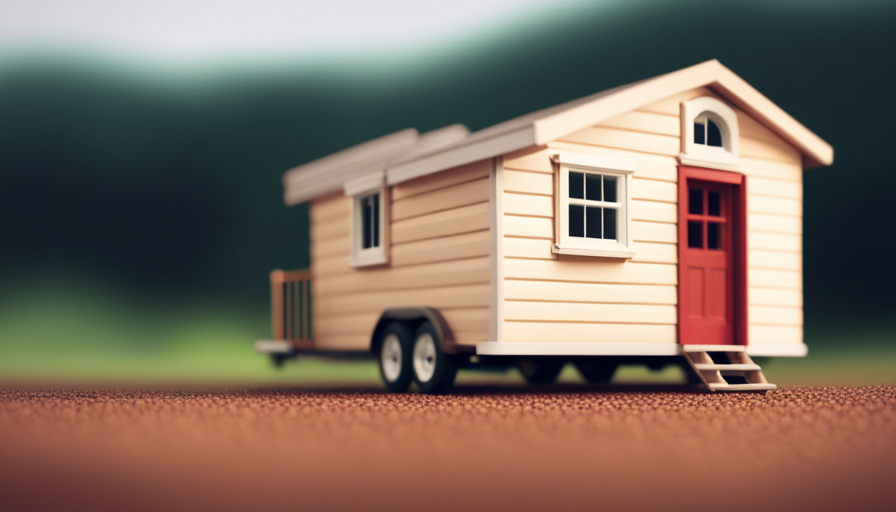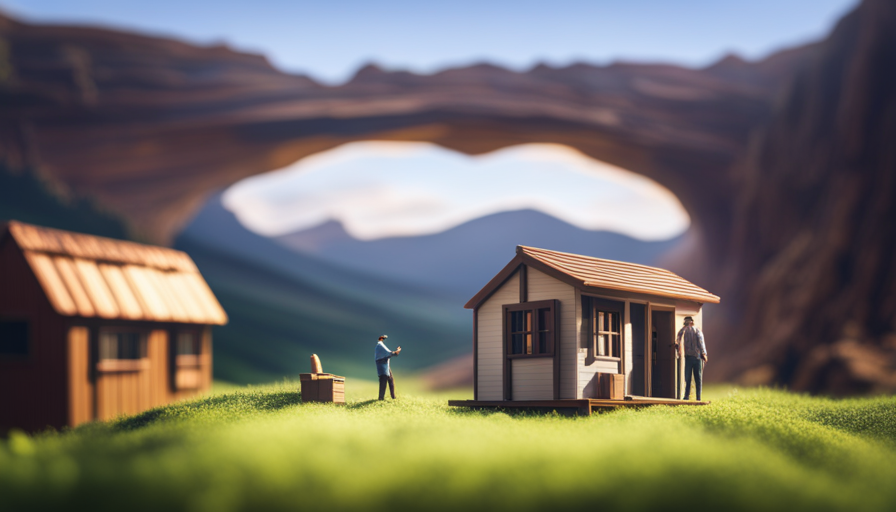Did you know that the average new single-family home in the United States is around 2,600 square feet? That’s pretty roomy!
But what if I told you that there’s a builder out there who is challenging the notion that bigger is always better? Graham Wales, a renowned tiny house builder, is pushing the boundaries of how small a home can be while still providing all the necessary amenities and comforts.
In this article, we’ll explore Graham’s innovative designs and how he maximizes space in his tiny houses. We’ll also delve into the idea of expanding the square footage of these homes and the challenges that come with it.
And finally, we’ll discuss the benefits of living in a larger tiny house and what the future holds for tiny house building.
So, if you’re curious about how big you can actually get with a tiny house, keep reading!
Key Takeaways
- Graham Wales is a renowned tiny house builder challenging the notion that bigger is always better.
- Sustainable techniques, such as rainwater harvesting and solar panels, are incorporated into Wales’ designs.
- Creative storage solutions and multi-functional furniture are used to maximize space in tiny houses.
- Building larger tiny houses can be challenging due to zoning regulations and traditional lenders, but financing options and grants exist to support these projects.
The Innovative Designs of Graham Wales
Graham Wales, known for his tiny house builds, showcases his innovative designs that push the boundaries of size. With a focus on innovative materials and sustainable building techniques, Wales has revolutionized the concept of tiny houses. He incorporates cutting-edge materials like reclaimed wood, recycled metal, and energy-efficient insulation to create eco-friendly and durable structures. Wales also utilizes sustainable building techniques such as rainwater harvesting, solar panels, and composting toilets to minimize the environmental impact of his designs. By combining these elements, he’s able to maximize the functionality and comfort of his tiny houses without sacrificing style or space.
Transitioning into the subsequent section about maximizing space in tiny houses, Wales’s designs cleverly utilize every inch of available space, creating a cozy and efficient living environment.
Maximizing Space in Tiny Houses
When it comes to tiny houses, maximizing space is essential. In order to make the most of the limited square footage, creative storage solutions are a must.
From built-in cabinets to hidden compartments, there are endless possibilities for storing belongings in a compact and efficient manner. Additionally, multi-functional furniture is another key element in maximizing space in tiny houses. By incorporating pieces that serve multiple purposes, such as a sofa that transforms into a bed or a dining table that can be folded away when not in use, homeowners can make every inch of their tiny house count.
Creative Storage Solutions
With a little creativity, the possibilities for storage in tiny houses are as expansive as the night sky, allowing homeowners to tuck away their belongings like stars in the universe.
Space saving organization is key in maximizing storage in tiny houses. Utilizing vertical space with shelves and hooks can help maximize storage capacity. Additionally, incorporating hidden storage options such as built-in cabinets or under-bed storage can provide clever solutions for storing items out of sight.
From utilizing the space under stairs to installing wall-mounted storage systems, there are countless ways to make the most of every inch in a tiny house.
Transitioning into the subsequent section about multi-functional furniture, it’s important to consider how these storage solutions can also be integrated into furniture pieces to further optimize space utilization.
Multi-functional Furniture
By incorporating multi-functional furniture, homeowners can transform their tiny space into a versatile oasis. A dining table can seamlessly convert into a work desk and a sofa can effortlessly unfold into a comfortable bed. Multi-functional furniture is a key element in space-saving solutions for small living spaces. These innovative pieces are designed with functionality in mind, offering homeowners the ability to maximize their limited square footage.
From storage ottomans that double as coffee tables to beds with built-in drawers, multi-functional furniture provides clever and efficient ways to store and organize belongings. Not only does this type of furniture save space, but it also adds style and sophistication to any tiny home. With the right combination of multi-functional furniture, homeowners can create a space that meets their needs and allows for easy transitions between different activities.
Transitioning into the next section about expanding the square footage of tiny houses, there are additional strategies for maximizing living space.
Expanding the Square Footage of Tiny Houses
When it comes to expanding the square footage of tiny houses, there are a few key points to consider.
One option is to utilize loft spaces and mezzanines, which can provide additional living or storage space.
Another possibility is to incorporate outdoor living areas, such as decks or patios, which can effectively extend the usable square footage of a tiny house.
Overall, these strategies can help maximize the space in tiny houses and create a more comfortable living environment.
Loft Spaces and Mezzanines
Loft spaces and mezzanines in Graham Wales’ tiny houses are so incredibly spacious, you won’t believe how much room you’ll have to relax and unwind! These innovative designs make the most of vertical space, maximizing the square footage available. Here’s why you’ll love the loft spaces in Graham Wales’ tiny houses:
-
Loft design: The loft areas are thoughtfully designed, with attention to detail and functionality. You’ll find ample headroom and clever storage solutions.
-
Space utilization: The loft spaces provide an additional living area without sacrificing the main floor’s functionality. Whether it’s a cozy bedroom or a versatile workspace, you’ll have plenty of room to make it your own.
-
Natural light: Large windows and skylights flood the loft spaces with natural light, creating a bright and inviting atmosphere.
-
Privacy: The loft areas are secluded from the main living area, providing a peaceful retreat where you can enjoy some quiet time.
-
Customization options: Graham Wales offers customization options, allowing you to tailor the loft space to your specific needs and preferences.
With the loft spaces in Graham Wales’ tiny houses, you’ll have a comfortable and functional living area that optimizes space utilization.
Speaking of optimizing space, let’s explore the outdoor living areas next.
Outdoor Living Areas
When it comes to tiny houses, maximizing every inch of space is crucial. In my previous discussion about loft spaces and mezzanines, I highlighted how these elevated areas can provide additional square footage for sleeping or storage. Now, let’s shift our attention to the great outdoors and explore the possibilities of outdoor living areas in tiny house design.
Outdoor living areas are a fantastic way to expand the usable space of a tiny house. Not only do they provide a breath of fresh air, but they also offer opportunities for outdoor cooking and entertaining. To create a seamless transition between indoor and outdoor spaces, landscaping design plays a crucial role. Incorporating elements like potted plants, outdoor furniture, and even a small garden can transform a tiny house into a cozy oasis.
In the next section, we’ll delve into the importance of incorporating natural light and views, further enhancing the connection between a tiny house and its surroundings.
Incorporating Natural Light and Views
Maximizing natural light and breathtaking views, Graham Wales, a skilled tiny house builder, knows how to create spacious and inviting spaces. When it comes to incorporating scenic views and harnessing natural light, Wales employs various design techniques that make his tiny houses feel open and connected to the outdoors.
Large windows and strategically placed skylights allow sunlight to flood the interior, creating a bright and airy atmosphere. Wales also takes advantage of the surrounding landscape, positioning windows to frame picturesque vistas and bring the outside in. By carefully selecting the location and orientation of his tiny houses, Wales ensures that occupants can enjoy stunning views while still maintaining privacy.
These design choices not only enhance the overall aesthetic appeal of the tiny houses but also contribute to a sense of tranquility and harmony with nature. Transitioning to the subsequent section about the challenges of building larger tiny houses, it is important to consider the limitations and complexities that arise when scaling up these compact dwellings.
The Challenges of Building Larger Tiny Houses
When it comes to incorporating natural light and views into tiny houses, Graham Wales has proven to be a master. However, as the size of these tiny houses increases, new challenges arise. One of the biggest obstacles is navigating the complex world of zoning regulations.
Many areas have strict rules about the size and placement of dwellings, making it difficult to build a larger tiny house. Financing can also be a challenge, as traditional lenders may be hesitant to provide loans for unconventional homes. Despite these challenges, there are options available for those looking to build a larger tiny house.
Some companies specialize in financing for alternative housing, and there are even grants and crowdfunding platforms dedicated to supporting these projects. Transitioning into the next section, let’s explore the benefits of living in a larger tiny house.
The Benefits of Living in a Larger Tiny House
Living in a larger tiny house allows for more flexibility and comfort, with the average size of a larger tiny house being around 400 square feet, providing ample space for everyday activities and even hosting small gatherings. Financial implications of living in a larger tiny house can be beneficial, as the initial investment may be higher, but the long-term savings on utilities and maintenance costs can outweigh the upfront expenses. Additionally, customization options are expanded in a larger tiny house, allowing for more personalized living spaces and the ability to incorporate desired amenities. Below is a comparison table highlighting the benefits of living in a larger tiny house:
| Benefits of Living in a Larger Tiny House |
|---|
| More space for activities |
| Ability to host small gatherings |
| Increased customization options |
This combination of financial implications and customization options makes living in a larger tiny house a viable and comfortable alternative to traditional housing. Transitioning into the future of tiny house building, innovative designs and sustainable materials will continue to shape the industry.
The Future of Tiny House Building
The future of tiny house building is filled with exciting possibilities, where innovative designs and sustainable materials will shape the industry. As technology continues to advance, we can expect to see new construction techniques and materials that will allow for even larger and more efficient tiny homes. Here are some key trends to watch out for:
-
Advanced insulation: With the use of advanced insulation materials, tiny houses can become even more energy-efficient, reducing the need for heating and cooling.
-
Smart home technology: Integrating smart home technology into tiny houses will allow for greater control over energy usage and increased convenience.
-
Vertical living: Utilizing vertical space through innovative designs like multi-level tiny houses or modular additions can maximize living space without sacrificing the small footprint.
-
3D printing: The use of 3D printing technology can revolutionize the construction process, making it faster, more cost-effective, and allowing for greater customization.
Incorporating these future technologies and sustainable materials will not only enhance the functionality and comfort of tiny houses but also contribute to reducing our ecological footprint.
Frequently Asked Questions
What are some of the unique features or design elements that Graham Wales incorporates into his tiny houses?
Graham Wales incorporates innovative storage solutions and sustainable materials into his tiny houses. He cleverly designs his homes to include hidden storage compartments and multi-purpose furniture, with a focus on maximizing space. Every inch is utilized efficiently, from built-in shelving to lofted sleeping areas. Additionally, he prioritizes sustainability by using eco-friendly materials such as reclaimed wood and energy-efficient appliances. These unique features not only make his tiny houses functional but also environmentally conscious.
How can homeowners maximize the limited space available in tiny houses?
To maximize storage in tiny houses, homeowners can utilize multi-purpose furniture. This type of furniture is designed to serve multiple functions, such as a sofa that can be transformed into a bed or a coffee table with hidden storage compartments.
Additionally, utilizing vertical space with shelves and wall-mounted storage solutions can help maximize storage without taking up valuable floor space.
With careful planning and thoughtful organization, homeowners can make the most of the limited space available in tiny houses.
Are there any innovative techniques or strategies to expand the square footage of tiny houses without compromising their mobility?
There are several innovative techniques to expand the square footage of tiny houses without compromising their mobility. One option is to incorporate multipurpose furniture, such as beds that can be folded into walls or tables that can be extended when needed.
Another strategy is to utilize vertical space by installing loft areas or high shelving units.
Additionally, some tiny house builders are exploring expandable designs that can be expanded or contracted based on the homeowner’s needs.
These innovative techniques allow for more living space while still maintaining the mobility of tiny houses.
How does Graham Wales incorporate natural light and views into his tiny house designs?
Incorporating natural light and views is a key element in my tiny house designs. I understand the importance of creating a sense of spaciousness in small spaces.
To maximize natural light, I strategically place windows and skylights throughout the house, allowing sunlight to flood in. Additionally, I carefully consider the placement of these windows to provide beautiful views of the surrounding landscape.
By prioritizing these design elements, I aim to create a bright and airy atmosphere within the limited space of a tiny house.
What are some of the biggest challenges that arise when building larger tiny houses, and how does Graham Wales address them?
Building larger tiny houses presents a unique set of challenges, but Graham Wales has found innovative solutions. One major challenge is maximizing space without compromising mobility. Wales incorporates multifunctional furniture and clever storage solutions to make the most of every inch.
He also expands square footage by utilizing lofts and outdoor living areas. To address the need for natural light and views, Wales incorporates large windows, skylights, and strategic placement of the house on the property.
His approach ensures that larger tiny houses feel spacious, inviting, and connected to the outdoors.
Conclusion
In conclusion, Graham Wales has revolutionized the world of tiny house building with his innovative designs and space-maximizing techniques. While some may argue that larger tiny houses defeat the purpose of downsizing, it’s important to consider the benefits they offer. For example, improved functionality and comfort. By incorporating natural light and views, Wales creates a sense of spaciousness and connection to the outdoors.
While challenges may arise when building larger tiny houses, the future of this industry holds exciting possibilities for those seeking a minimalist lifestyle without sacrificing space.
Hi, I’m Emma. I’m the Editor in Chief of Tiny House 43, a blog all about tiny houses. While tree houses are often associated with childhood, they can be the perfect adult retreat. They offer a cozy space to relax and unwind, surrounded by nature. And since they’re typically built on stilts or raised platforms, they offer stunning views that traditional homes simply can’t match. If you’re looking for a unique and romantic getaway, a tree house tiny house might just be the perfect option.
